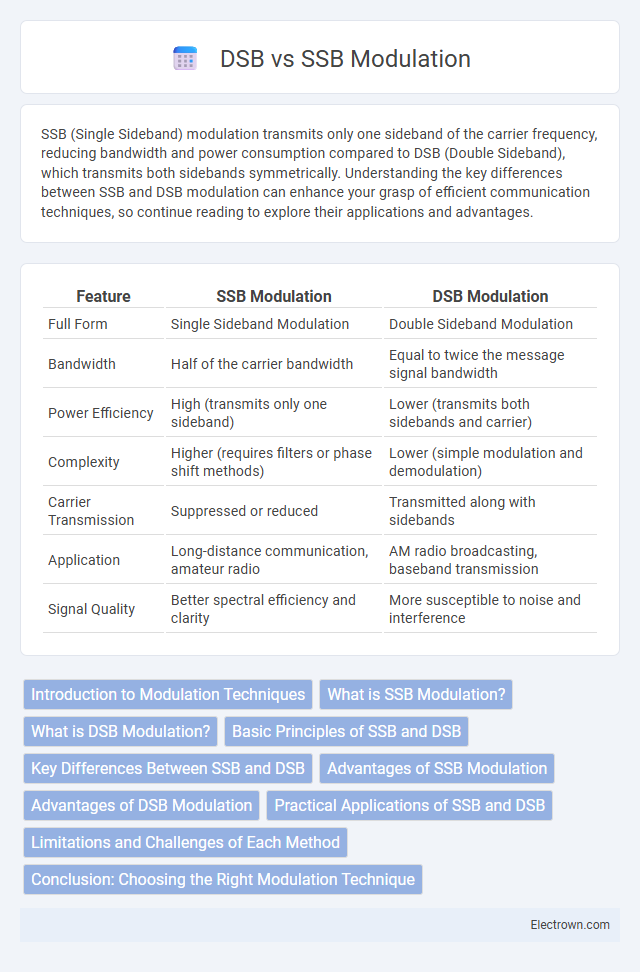SSB (Single Sideband) modulation transmits only one sideband of the carrier frequency, reducing bandwidth and power consumption compared to DSB (Double Sideband), which transmits both sidebands symmetrically. Understanding the key differences between SSB and DSB modulation can enhance your grasp of efficient communication techniques, so continue reading to explore their applications and advantages.
Table of Comparison
| Feature | SSB Modulation | DSB Modulation |
|---|---|---|
| Full Form | Single Sideband Modulation | Double Sideband Modulation |
| Bandwidth | Half of the carrier bandwidth | Equal to twice the message signal bandwidth |
| Power Efficiency | High (transmits only one sideband) | Lower (transmits both sidebands and carrier) |
| Complexity | Higher (requires filters or phase shift methods) | Lower (simple modulation and demodulation) |
| Carrier Transmission | Suppressed or reduced | Transmitted along with sidebands |
| Application | Long-distance communication, amateur radio | AM radio broadcasting, baseband transmission |
| Signal Quality | Better spectral efficiency and clarity | More susceptible to noise and interference |
Introduction to Modulation Techniques
SSB (Single Sideband) and DSB (Double Sideband) modulation are key techniques used to transmit signals by varying a carrier wave's amplitude. DSB transmits both upper and lower sidebands, doubling bandwidth usage, while SSB transmits only one sideband, improving spectral efficiency and reducing power consumption. Understanding these modulation methods helps optimize your communication system for clearer signal transmission and efficient bandwidth use.
What is SSB Modulation?
SSB modulation, or Single Sideband Modulation, is a refined form of amplitude modulation that transmits only one sideband, either upper or lower, while suppressing the carrier signal and the other sideband. This technique significantly reduces bandwidth usage by nearly half compared to conventional Double Sideband (DSB) modulation, making it highly efficient for communication systems. Additionally, SSB modulation enhances signal clarity and power efficiency, which is crucial in long-distance radio transmissions and voice communication applications.
What is DSB Modulation?
Double Sideband (DSB) modulation is a form of amplitude modulation where the carrier signal is modulated by the baseband message signal, producing two symmetrical sidebands around the carrier frequency. This technique transmits both the upper and lower sidebands, doubling the bandwidth required compared to single sideband modulation. Despite its simplicity, DSB modulation is less bandwidth-efficient and more susceptible to noise compared to Single Sideband (SSB) modulation.
Basic Principles of SSB and DSB
Single Sideband (SSB) modulation transmits only one sideband of the carrier frequency, either upper or lower, reducing bandwidth and power consumption. Double Sideband (DSB) modulation transmits both upper and lower sidebands along with the carrier, effectively doubling the bandwidth compared to SSB. SSB's efficiency in spectrum utilization and power makes it ideal for long-distance communication, while DSB's simpler implementation suits applications where bandwidth is less constrained.
Key Differences Between SSB and DSB
SSB (Single Sideband) modulation transmits only one sideband of the carrier signal, either upper or lower, significantly reducing bandwidth and power consumption compared to DSB (Double Sideband) modulation, which transmits both sidebands. DSB uses twice the bandwidth of SSB and requires more power, making SSB more efficient for long-distance communication and reducing interference. Your communication system benefits from SSB's spectral efficiency, while DSB is simpler to implement but less optimal in bandwidth and power usage.
Advantages of SSB Modulation
SSB modulation offers significant bandwidth efficiency by transmitting only one sideband, which reduces the required spectrum to half compared to DSB modulation. This efficiency also translates to decreased power consumption, making SSB ideal for long-distance communication such as amateur radio and marine transmissions. Your communication system benefits from reduced interference and improved signal clarity due to the elimination of the carrier and one sideband in SSB modulation.
Advantages of DSB Modulation
DSB (Double Sideband) modulation offers the advantage of simpler transmitter and receiver design compared to other modulation schemes. It provides better power efficiency than AM because both sidebands carry the same information, enhancing signal robustness. DSB modulation also supports straightforward demodulation with coherent detection, ensuring improved signal quality in various communication systems.
Practical Applications of SSB and DSB
SSB modulation is widely used in long-distance and maritime communications due to its bandwidth efficiency and reduced power consumption, making it ideal for HF radio transmissions. DSB modulation finds practical applications in AM broadcasting and standard voice transmission systems where simplicity and compatibility with legacy receivers are priorities. SSB's spectral efficiency supports amateur radio and aeronautical communication, while DSB's straightforward implementation suits general audio and public broadcast environments.
Limitations and Challenges of Each Method
Single Sideband (SSB) modulation faces challenges with complex receiver design and precise filtering requirements to avoid signal distortion. Double Sideband (DSB) modulation suffers from power inefficiency and bandwidth wastage due to the transmission of redundant sidebands. Understanding these limitations helps you choose the appropriate modulation method for efficient communication system design.
Conclusion: Choosing the Right Modulation Technique
Choosing the right modulation technique depends on your specific communication needs, such as bandwidth efficiency and power consumption. Single Sideband (SSB) modulation offers superior bandwidth savings and reduced power usage compared to Double Sideband (DSB) modulation, making it ideal for long-distance and spectrum-constrained applications. If simplicity and compatibility with existing AM receivers are priorities, DSB may be more suitable despite its higher bandwidth and power requirements.
SSB vs DSB Modulation Infographic

 electrown.com
electrown.com